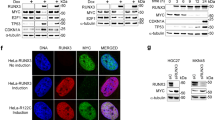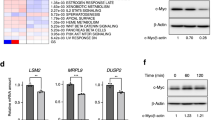Abstract
The small GTPase RhoB suppresses cancer in part by limiting cell proliferation. However, the mechanisms it uses to achieve this are poorly understood. Recent studies link RhoB to trafficking of Akt, which through its regulation of glycogen synthase kinase-3 (GSK-3) has an important role in controlling the stability of the c-Myc oncoprotein. c-Myc stabilization may be a root feature of human tumorigenesis as it phenocopies an essential contribution of SV40 small T antigen in human cell transformation. In this study we show that RhoB directs efficient turnover of c-Myc in established or transformed mouse fibroblasts and that the attenuation of RhoB which occurs commonly in human cancer is a sufficient cause to elevate c-Myc levels. Increased levels of c-Myc elicited by RhoB deletion increased the proliferation of nullizygous cells, whereas restoring RhoB in null cells decreased the stability of c-Myc and restrained cell proliferation. Mechanistic analyses indicated that RhoB facilitated nuclear accumulation of GSK-3 and GSK-3-mediated phosphorylation of c-Myc T58, the critical site for ubiquitination and degradation of c-Myc. RhoB deletion restricted nuclear localization of GSK-3, reduced T58 phosphorylation, and stabilized c-Myc. These effects were not associated with changes in phosphorylation or localization of Akt, however, differences were observed in phosphorylation and localization of the GSK-3 regulatory Akt-related kinase, serum- and glucocorticoid-inducible protein kinase (SGK). The ability of RhoB to support GSK-3-dependent turnover of c-Myc offers a mechanism by which RhoB acts to limit the proliferation of neoplastically transformed cells.
This is a preview of subscription content, access via your institution
Access options
Subscribe to this journal
Receive 50 print issues and online access
$259.00 per year
only $5.18 per issue
Buy this article
- Purchase on Springer Link
- Instant access to full article PDF
Prices may be subject to local taxes which are calculated during checkout







Similar content being viewed by others
References
Adamson P, Paterson HF, Hall A . (1992). J Cell Biol 119: 617–627.
Adini I, Rabinowitz I, Sun JF, Prendergast GC, Benjamin LE . (2003). Genes Dev 17: 2721–2732.
Adnane J, Muro-Cacho C, Mathews L, Sebti SM, Munoz-Antonia T . (2002). Clin Cancer Res 8: 2225–2232.
Alarcon-Vargas D, Ronai Z . (2004). J Biol Chem 279: 5008–5016.
Alarcon-Vargas D, Tansey WP, Ronai Z . (2002). Oncogene 21: 4384–4391.
Bhatia K, Huppi K, Spangler G, Siwarski D, Iyer R, Magrath I . (1993). Nat Genet 5: 56–61.
Bhatia K, Spangler G, Gaidano G, Hamdy N, Dalla-Favera R, Magrath I . (1994). Blood 84: 883–888.
Chen Z, Sun J, Pradines A, Favre G, Adnane J, Sebti SM . (2000). J Biol Chem 275: 17974–17978.
Du W, Lebowitz P, Prendergast GC . (1999). Mol Cell Biol 19: 1831–1840.
Firestone GL, Giampaolo JR, O'Keeffe BA . (2003). Cell Physiol Biochem 13: 1–12.
Flinn EM, Busch CM, Wright AP . (1998). Mol Cell Biol 18: 5961–5969.
Flynn P, Mellor H, Casamassima A, Parker PJ . (2000). J Biol Chem 275: 11064–11070.
Gampel A, Parker PJ, Mellor H . (1999). Curr Biol 9: 955–958.
Gregory MA, Qi Y, Hann SR . (2003). J Biol Chem 278: 51606–51612.
Henriksson M, Bakardjiev A, Klein G, Luscher B . (1993). Oncogene 8: 3199–3209.
Jaffe AB, Hall A . (2002). Adv Cancer Res 84: 57–80.
Jiang K, Coppola D, Crespo NC, Nicosia SV, Hamilton AD, Sebti SM et al. (2000). Mol Cell Biol 20: 139–148.
Liu A-X, Prendergast GC . (2000). FEBS Lett 481: 205–208.
Liu A-X, Cerniglia GJ, Bernhard EJ, Prendergast GC . (2001a). Proc Natl Acad Sci USA 98: 6192–6197.
Liu A-X, Du W, Liu J-P, Jessell TM, Prendergast GC . (2000). Mol Cell Biol 20: 6105–6113.
Liu A-X, Rane N, Liu J-P, Prendergast GC . (2001b). Mol Cell Biol 21: 6906–6912.
Lutterbach B, Hann SR . (1994). Mol Cell Biol 14: 5510–5522.
Mazieres J, Antonia T, Daste G, Muro-Cacho C, Berchery D, Tillement V et al. (2004). Clin Cancer Res 10: 2742–2750.
Mellor J, Flynn P, Nobes CD, Hall A, Parker PJ . (1998). J Biol Chem 273: 4811–4814.
Nesbit CE, Tersak JM, Prochownik EV . (1999). Oncogene 18: 3004–3016.
Papas TS, Lautenberger JA . (1985). Nature 318: 237.
Prendergast GC . (2001). Nat Rev Cancer 1: 162–168.
Pulverer BJ, Fisher C, Vousden K, Littlewood T, Evan G, Woodgett JR . (1994). Oncogene 9: 59–70.
Sahai E, Marshall CJ . (2002). Nat Rev Cancer 2: 133–142.
Sakoda H, Gotoh Y, Katagiri H, Kurokawa M, Ono H, Onishi Y et al. (2003). J Biol Chem 278: 25802–25807.
Salghetti SE, Kim SY, Tansey WP . (1999). EMBO J 18: 717–726.
Sandilands E, Cans C, Fincham VJ, Mellor H, Prendergast GC, Brunton VG et al. (2004). Dev Cell 7: 855–869.
Sears R, Leone G, DeGregori J, Nevins JR . (1999). Mol Cell 3: 169–179.
Sears R, Nuckolls F, Haura E, Taya Y, Tamai K, Nevins JR . (2000). Genes Dev 14: 2501–2514.
Sears RC . (2004). Cell Cycle 3: 1133–1137.
Skehan P, Storeng R, Scudiero D, Monks A, McMahon J, Vistica D et al. (1990). J Natl Cancer Inst 82: 1107–1112.
Tetzlaff MT, Yu W, Li M, Zhang P, Finegold M, Mahon K et al. (2004). Proc Natl Acad Sci USA 101: 3338–3345.
Wang S, Yan-Neale Y, Fischer D, Zeremski M, Cai R, Zhu J et al. (2003). Oncogene 22: 6204–6213.
Wang S, Yan-Neale Y, Zeremski M, Cohen D . (2004). Novartis Found Symp 259: 238–245; discussion 245–248, 285–288.
Wei W, Jin J, Schlisio S, Harper JW, Kaelin Jr WG . (2005). Cancer Cell 8: 25–33.
Welcker M, Orian A, Grim JA, Eisenman RN, Clurman BE . (2004a). Curr Biol 14: 1852–1857.
Welcker M, Orian A, Jin J, Grim JA, Harper JW, Eisenman RN et al. (2004b). Proc Natl Acad Sci USA 101: 9085–9090.
Wherlock M, Gampel A, Futter C, Mellor H . (2004). J Cell Sci 117: 3221–3231.
Yada M, Hatakeyama S, Kamura T, Nishiyama M, Tsunematsu R, Imaki H et al. (2004). EMBO J 23: 2116–2125.
Yeh E, Cunningham M, Arnold H, Chasse D, Monteith T, Ivaldi G et al. (2004). Nat Cell Biol 6: 308–318.
Zeng P-Y, Rane N, Du W, Chintapalli J, Prendergast GC . (2003). Oncogene 22: 1124–1134.
Acknowledgements
We thank J DuHadaway and PS Donover for providing expert technical assistance. This work was supported by NIH Grants CA82222 and CA100123 to GP and by the Lankenau Hospital Foundation. MH is the recipient of an EB Churchman Research Fellowship. UK is supported by a DoD Breast Cancer Research Postdoctoral Fellowship.
Author information
Authors and Affiliations
Corresponding author
Rights and permissions
About this article
Cite this article
Huang, M., Kamasani, U. & Prendergast, G. RhoB facilitates c-Myc turnover by supporting efficient nuclear accumulation of GSK-3. Oncogene 25, 1281–1289 (2006). https://doi.org/10.1038/sj.onc.1209174
Received:
Revised:
Accepted:
Published:
Issue Date:
DOI: https://doi.org/10.1038/sj.onc.1209174
Keywords
This article is cited by
-
Sgk1 activates MDM2-dependent p53 degradation and affects cell proliferation, survival, and differentiation
Journal of Molecular Medicine (2009)



